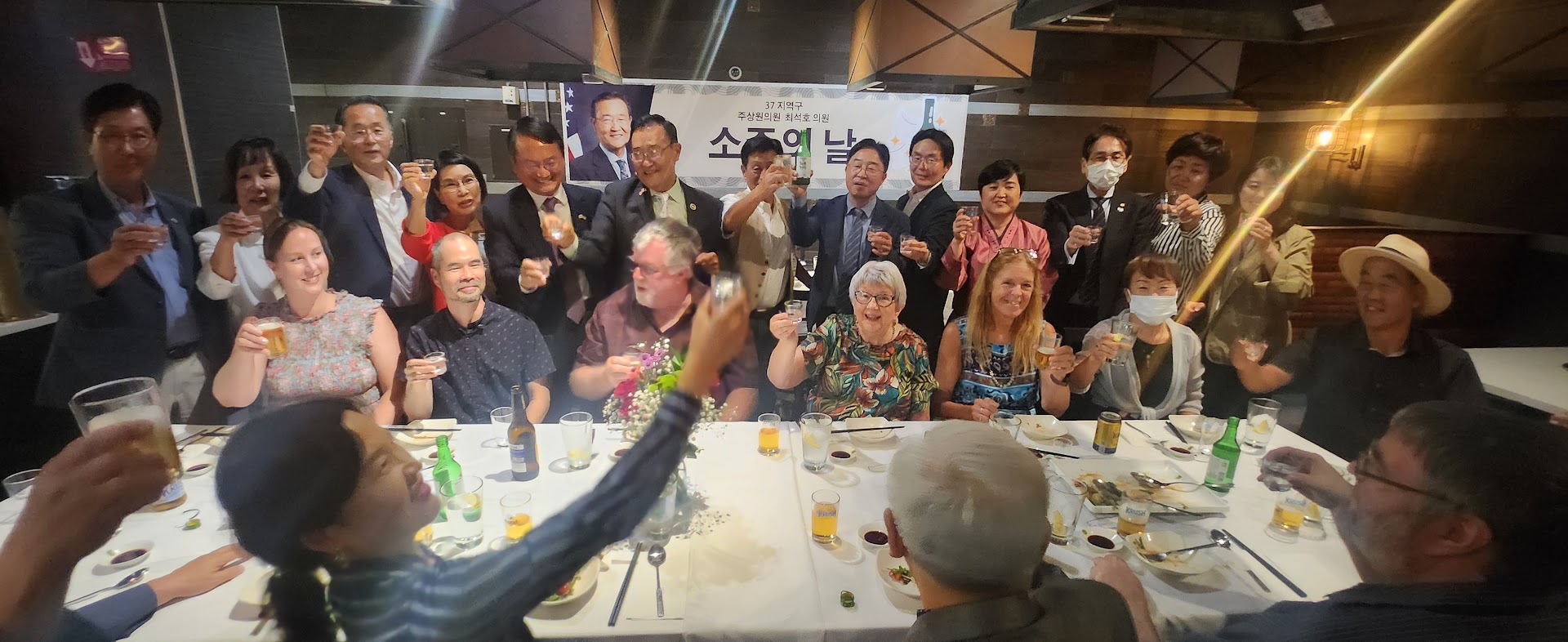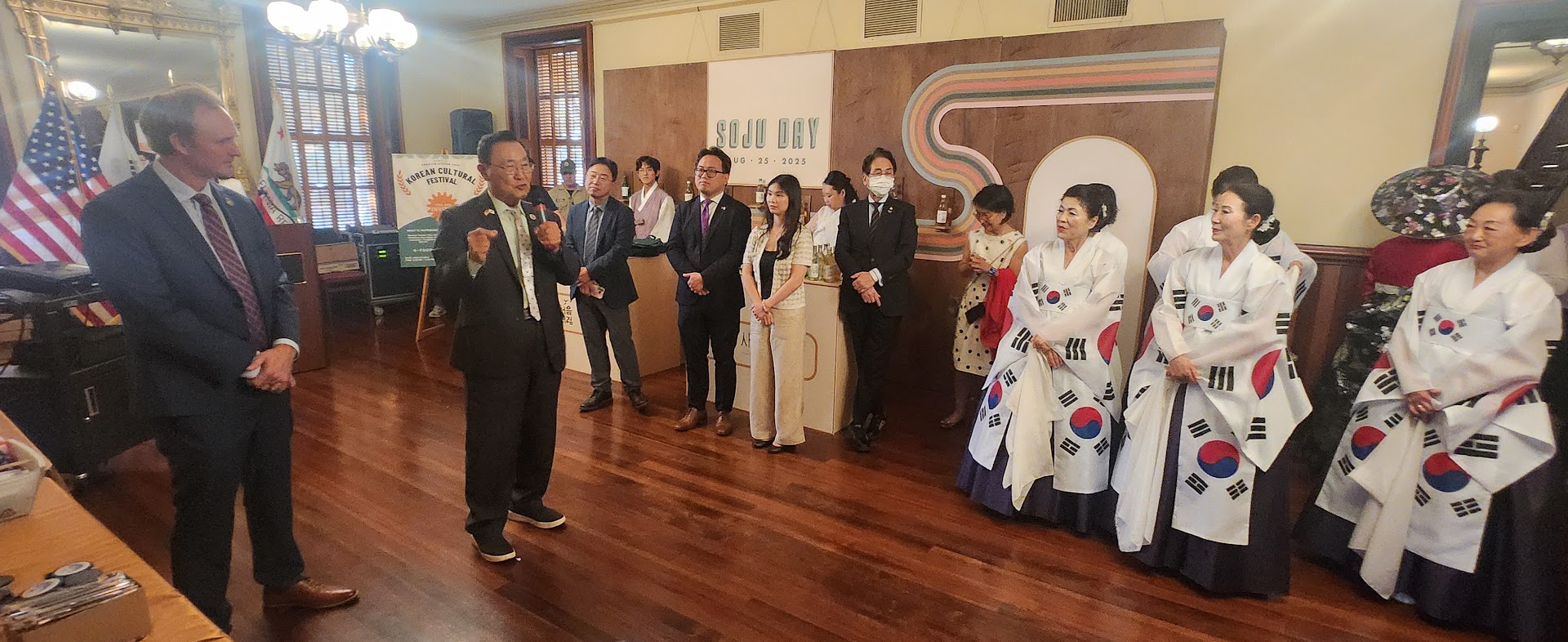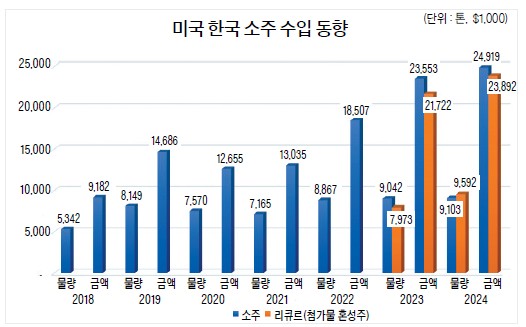At the California State Assembly proclamation of “Soju Day”
State legislature designates September 20 every year
Tasting events heat up the Capitol and banquet hall
Need for strengthened authenticity and competitiveness amid local “wine soju” trend

The California State Capitol in Sacramento and its surroundings were swept up in the “sweet and bittersweet” taste of soju.
On the 25th, the resolution for “Soju Day” (SCR 95), led by California State Senator Steven Choi (District 37), was proclaimed.
This resolution designates September 20 every year as Soju Day, with the purpose of promoting not only soju sold in the U.S. but also the Korean culture associated with it, and sharing it together.
Twenty-one senators from both the Democratic and Republican parties took part in the resolution, while Assemblymembers Mark Gonzalez (District 54) and Sharon Quirk-Silva (District 67), who represent Koreatowns in Los Angeles and Orange County, joined as co-authors, adding significance.
Senator Choi, regarding the resolution’s passage, said, “Soju is a drink that embodies the joys and sorrows of Koreans, carrying on its culture for a long time. Here in California, home to the largest Korean population in the U.S., it is also beloved. I hope this resolution will help soju, which is already loved, become known to even more people and serve as a catalyst to strengthen the Korean Wave.”
State senators applauded Korean community leaders and liquor industry figures who visited the Assembly following the resolution’s passage.

That evening, Senator Choi acted as a soju salesman, drawing the attention of colleagues and participants throughout the event.
In the afternoon, a tasting event was held at the nearby Stanford Mansion banquet hall, accompanied by a Korean food exhibition, and at 7 p.m., a celebratory dinner was held with lawmakers, educators, and Korean community leaders. State legislators, aides, and community figures marveled at the taste of Korean fruit soju and traditional dance performances.
Assemblymember James Gallagher (District 3, Sacramento Valley), who was the first to propose the Soju Day resolution, also joined the tasting event and could not hide his satisfaction.
He said, “Growing up in a farmer’s family, I know well the impact of drinks made from good grains on the community. Soju does not end with eating, drinking, and enjoying—it will also bring economic prosperity to us all,” drawing applause.
At the tasting event, expectations went beyond soju itself.

Rowena Tomaneng, Vice Chancellor of a California Community College, said, “I remember well my immigrant father-in-law who first settled in the U.S. I hope the success of Hallyu and soju will eventually lead to advances in Korean language and history education within the school system.”
Another attendee, who introduced himself as chief of staff to a Sacramento County supervisor, said, “I never knew there were so many different kinds of fruit soju. If these become more visible in grocery stores or major retail chains, Americans will definitely come to love it.”
Industry insiders also admitted they did not expect soju to gain such popularity in the U.S.
Kyungdong Kim, head of Lotte Chilsung Beverage’s U.S. branch, said, “Without the Korean Wave, we could not have promoted the great taste of soju like this. Now is truly the time to elevate the status of our soju with authentic flavor, style, and quality.”
In fact, Korea’s soju has achieved remarkable records in the U.S., a market where countless kinds of domestic hard liquor and European wines compete.
For the Korean community, soju’s beginning was not easy. In the 1970s and 80s, during the early years of immigration, it was an expensive and rare drink. Not only did it take a week by ship to arrive, but it was classified as hard liquor and subject to relatively high tariffs. In those days, drinking soju at restaurants to recall memories of the homeland cost more than $10 a bottle—when a bowl of seolleongtang cost only $4–6. Some heavy drinkers used to say they had to sip carefully and sparingly.
After 2000, as distribution networks improved and exports increased, soju became available in Korean markets for just $2–3 a bottle.
The variety also expanded. While the U.S. soju market had initially been dominated by Jinro, now more than 10 companies—including Lotte, Bohae, Muhak, and Hallasan—compete.
 Currently, the U.S. is the second-largest importer of Korean soju (after Japan), followed by China, Vietnam, and the Philippines.
Currently, the U.S. is the second-largest importer of Korean soju (after Japan), followed by China, Vietnam, and the Philippines.
According to the Korea Agro-Fisheries & Food Trade Corporation (aT), since official statistics began in 2018, U.S. imports of soju have steadily increased, reaching 9,103 tons in 2024 (worth $24.91 million).
Notably, fruit-flavored soju surpassed traditional soju exports for the first time in 2024, recording 9,592 tons.
But the growth of fruit soju also raises new challenges.
Lowering alcohol content to around 6–8% has expanded the domestic market, but wine-based sojus that do not rely on distilled ethanol are increasingly appearing.
Some are imported from Korea, but around 10 companies now produce and sell so-called “American soju” locally, raising their market share.
For example, a Florida-based brand clearly stated on its packaging that it was made with wine, yet still included “soju” in its brand name. The packaging also featured the word “soju” in Korean, appealing to fans of K-dramas. Reviews on taste and aroma are divided.
Watching the passage of the Soju Day resolution and the tasting event, Baek Yutae, head of the aT Center in Los Angeles, said: “It is true there is some uncomfortable tension within the industry, but applying traditional soju standards to Korean manufacturers’ export activities may not always be reasonable. Ultimately, consumers’ tastes and preferences will naturally set the standards.”
Experts and Korean community leaders who attended the passage of the resolution and tasting event agreed that related initiatives are likely to spread to other states and expand the industry further.




